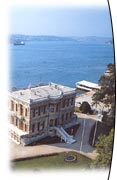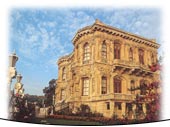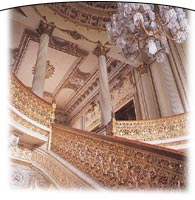Küçüksu Palace
KÜÇÜKSU PAVILION
 This attractive part of the İstanbul strait on the Asian shore is mentioned by Byzantine historians, and in Ottoman times became one of the imperial parks known as Kandil Bahçesi (Lantern Garden). Sultan Murad IV (1623-1640) was particularly fond of Küçüksu and gave it the name Gümüş Selvi (Silver Cypress), and in several sources from the l7th century onwards the name Bağçe-i Göksu is used.
This attractive part of the İstanbul strait on the Asian shore is mentioned by Byzantine historians, and in Ottoman times became one of the imperial parks known as Kandil Bahçesi (Lantern Garden). Sultan Murad IV (1623-1640) was particularly fond of Küçüksu and gave it the name Gümüş Selvi (Silver Cypress), and in several sources from the l7th century onwards the name Bağçe-i Göksu is used.
During the reign of Mahmud I (1730- 1754) Divittar Mehmed Paşa built a two storey timber palace on the waterfront here which continued to be used by Selim III (1789-1807) and Mahmud II (1808-1839).
 During the reign of Mahmud’s son Abdülmecid (1839-1861) the western influence on Turkish architecture reached a peak, and the sultan had the earlier building demolished and the present stone pavilion or royal lodge constructed in the new style used for Dolmabahçe and Ihlamur.
During the reign of Mahmud’s son Abdülmecid (1839-1861) the western influence on Turkish architecture reached a peak, and the sultan had the earlier building demolished and the present stone pavilion or royal lodge constructed in the new style used for Dolmabahçe and Ihlamur.
Küçüksu Pavilion was designed by Nikoğos Balyan and completed in 1857. The pavilion has a ground area of 15x27 meters and consists of a basement and two main storeys, the basement containing a larder, kitchen and servants, quarters. Both first and second floors have four corner rooms opening onto a central gallery, a plan which reflects that of the traditional Turkish house.  The pavilion was designed for short stays when the sultan took country excursions or went hunting in the woodland here. Unlike other imperial buildings Küçüksu was not surrounded by high walls but by castiron railings with gates on all four sides. During the reign of Abdülmecid’s younger brother Abdülaziz (1861-1876) more elaborate decoration was added to the façade. All the outbuildings which once belonged to the pavilion have since been demolished.
The pavilion was designed for short stays when the sultan took country excursions or went hunting in the woodland here. Unlike other imperial buildings Küçüksu was not surrounded by high walls but by castiron railings with gates on all four sides. During the reign of Abdülmecid’s younger brother Abdülaziz (1861-1876) more elaborate decoration was added to the façade. All the outbuildings which once belonged to the pavilion have since been demolished.
The ornate seaward façade and double flight of steps sweeping exuberantly around the ornamental pool and fountain are decorated with diverse western motifs. This European exterior is echoed in the interior furnishing and, decoration executed by Sechan, stage designer at Vienna Opera House.
 The ceilings are richly decorated with carton-pierre moulding and painted designs. There are so many fireplaces made of Italian marble of various colours in diverse styles, that Küçüksu is like a museum of l9th century fireplace design. The elegant parquet floors have different patterns in each of the rooms, which are furnished with European style furniture, carpets and paintings. After the establishment of the Turkish Republic, Küçüksu Pavilion was used as a state guest house for some years, but today is open to the public as a museum-palace.
The ceilings are richly decorated with carton-pierre moulding and painted designs. There are so many fireplaces made of Italian marble of various colours in diverse styles, that Küçüksu is like a museum of l9th century fireplace design. The elegant parquet floors have different patterns in each of the rooms, which are furnished with European style furniture, carpets and paintings. After the establishment of the Turkish Republic, Küçüksu Pavilion was used as a state guest house for some years, but today is open to the public as a museum-palace.
The pavilion was extensively restored in 1994 and the surrounding garden and parkland, nearby fountain and quay are now being transformed into a park where the public can enjoy picnics and excursions as in previous centuries. When this project is completed, the garden of Küçüksu Pavilion will be available for private receptions upon application.